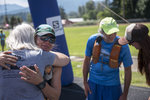
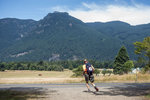
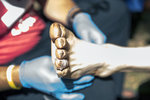
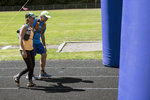
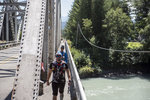
The first two days of the Bigfoot 200 race went about as swimmingly as a 206.5-mile race through volcano country and heavily forested backwoods can be expected to go. New course records were set for both men and women, and no serious injuries or emergencies had been reported for any of the 108 runners who started the race.
Then, Monday night, Aug. 14, rolled around, and a runner went missing.
That’s when race organizer Candice Burt and aid station volunteer Jeff Quick kicked into an adrenaline-charged high gear.
First, the runner missed his check-in time at an aid station along the trail. Then he started sending messages to his wife asking for help. When he finally pushed the SOS button on his spot tracker beacon, Quick and Burt quickly loaded their packs with emergency supplies and hit the trail to go find him.
Burt was confident that she would be able to locate the missing runner, noting that she knows this area like the back of her hand.
Sure enough, after a 6.5-mile hike to get to the runner’s approximate location, Quick and Burt were able to locate the man about 1,000 feet off course down at the bottom of a ravine.
“He was really confused and tired and probably hallucinating, I found out later,” said Burt, who said the runner was about 185 miles into the race when he got lost. “So it wasn’t exactly a cake walk.”
Burt was relieved to find that the runner was not injured, only exhausted, and the trio began to make their way back toward the nearest aid station for some much needed respite for the runner. While they made their way to the aid station, the rescued runner began to talk incoherently about things he had seen in the woods while waiting seven hours for his rescue. He insisted that there were piles of hundreds of discarded cellphones that had been lit on fire and that gang graffiti covered the trees.
“That’s when we made the smart decision to call it a day for him,” said Burt with the kind of laugh that emerges from the fog of hindsight.
The rescue mission was just another adventure for Burt, who runs in and organizes ultra-marathons around the Western United States. She noted with pride that she was able to reach the runner in time to call off the search and rescue party that was dispatched by the runner’s spot tracker beacon.
“You want them to know there’s a situation but we’re better equipped to respond and get out there. We’re ultra-runners. We just threw on our packs and went out and found him,” said Burt.
Quick said that while many runners chose to undertake the Bigfoot 200 alone, he sees an inherent value in running with a partner the whole way or interchanging fresh pace runners at the various aid stations along the route.
“Pacers, in my opinion, are the most important thing to keep people on trail. There’s a couple of gnarly spots out there with sheer dropoffs, and if you’re seeing things you might just walk right off,” said Quick. “It’s an endurance race but you’ll see a lot of people pairing up and crossing the finish line together. Either that or they’re like, screw this, I’m going to kick your butt this last mile.”
The race course includes 14 aid stations in all, with the longest gap between stations sitting at about 20 miles. Six of those stations are full sleep/aid stations where runners are free to hit the hay in a tent for a spell if they so desire. However, Burt says that most runners average only about five hours of sleep over the entirety of the race. She says that some people will run it straight through without any rest at all while others will log about 10 hours of sleep over the four and a half-day race.
As if a 206.5-mile course with nearly 100,000 feet of elevation gain wouldn't be enough to wreck most runners, Burt makes sure to add a few out-and-back sections to the course each year where runners have to experience the physical and mental anguish of retracing their steps in order to attain spectacular vistas of the verdant terrain at Mount Margaret, Elk Peak and Pompey Peak.
“They’re vantage points but it also makes it a little bit more challenging both mentally and physically. The runners really love me for that,” noted Burt through a thick fog of sarcasm.
Her devious design has a well-intentioned purpose, though.
“In this terrain sometimes you have to pop above the canopy to really see the scenery,” explained Burt.
Although this year’s course was 0.7 of a mile longer than last year, new records were set for both the men and women’s finishing times. Jason Kinsella shattered the old record, which was set at 62 hours 18 minutes last year by Richard Kresser, by cruising across the finish line in 55 hours and 49 minutes. Van Phan set the new women’s record with a time of 72 hours and 22 minutes.
“It’s pretty awesome to have both records get set in the same year,” said Burt.
Although he was not a record-setting runner, Joe Mokszycki had the time of his life while running his first ever ultramarathon. Mokszycki, 61, of Winchester, New York, ran only a pair of 50-mile races to get himself prepared for the Bigfoot 200 but after stopping to have some “hot spots” on his feet treated at the Owen’s Creek aid station he was cruising right along on Tuesday afternoon.
“I don’t think too many people thought I’d make it. I know my brothers didn’t. But I did. They just don’t know me,” said Mokszycki, who noted that it was the flat stretches of the run that were his least favorite after nearly 200 miles of the race. “The first half is always the physical and the second half is the mental. That’s why a lot of your best runners don’t finish.”
Angela Wilder, of McCleary, was another first-time Bigfoot 200 runner who managed to cross the finish line on Tuesday before the cutoff. With welling tears in her eyes as she stood on the track at White Pass High School, Wilder summed up the Bigfoot 200 in two words — “It’s sadistic!”
Wilder, who has previously run the Cascade Crest 100 race, said the Bigfoot 200 was about “one hundred times harder.”
“I would call it life changing,” said Wilder. “I always knew I would finish but it’s really, really horrible. I’m glad it’s over.”